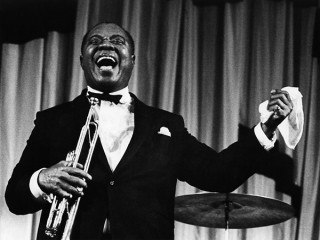
Louis Armstrong biography
Date of birth : 1901-08-04
Date of death : 1971-07-06
Birthplace : New Orleans, Louisiana, U.S.
Nationality : American
Category : Arts and Entertainment
Last modified : 2010-05-20
Credited as : Swing Jazz trumpeter and singer, West End Blues ,
Known for his brilliant improvisation techniques both onstage and during recordings, Louis Armstrong became one of the Jazz movement’s most important musicians. As his trumpet would cease, his voice would shine. Able to perform and improvise with his voice as much as with his trumpet, he laid the foundation for a long-lasting, ideal and charismatic career.
Born into the poverty of southern Louisiana, young Louis listened to music whenever he had the chance. The first instrument he learned to play was the brass cornet, which he obtained thanks to a small loan from another family. He even played in a few southern get-togethers and was astonished by the playing of Joe King Oliver, who was Armstrong’s early inspiration.
By his latter teenage years, Louis Armstrong moved to Chicago to play with Oliver – where Jazz was hot and the hottest band was Oliver’s. In these early and influential years, he was even a part of the band’s recordings, where one can easily hear Armstrong’s back-up cornet and snippets where Louis would be given a solo.
As the Chicago experience came and went, Armstrong saw greater opportunity in New York, where he would play the trumpet with the biggest Jazz band of the day, the Fletcher Henderson Orchestra. After his success in New York, Armstrong headed back to his beloved Chicago where he began recording his own songs – an eclectic mix of Jazz music. His first hits were Potato Head Blues, West End Blues and later in his career, he released Hello, Dolly, which topped the British charts followed by the charts in the U.S.
In 1929, Armstrong toured Europe and had profound success. When he came back to the United States, he relentlessly toured for the next three decades. He released such hits as What a Wonderful World, Stardust, and the catchy Dream a Little Dream of Me. His gregarious attitude and wide grin aided him during his onstage performances. People of all backgrounds loved his music. And, while no official autobiography was ever released, the development of his vocal recordings only caused his success to mushroom beyond his creative brass talents where everyone would recognize his distinct sound.
Armstrong appeared in more than a dozen Hollywood films, usually playing a band leader or musician. His most familiar role was as the bandleader cum narrator in the 1956 musical, High Society, in which he sang the title song and performed a duet with Bing Crosby on "Now You Has Jazz". In 1947, he played himself in the movie New Orleans opposite Billie Holiday, which chronicled the demise of the Storyville district and the ensuing exodus of musicians from New Orleans to Chicago. He was the first African American to host a nationally broadcast radio show in the 1930s. In 1969, Armstrong had a cameo role in the film version of Hello, Dolly! as the bandleader, Louis, to which he sang the title song with actress Barbra Streisand. His solo recording of "Hello, Dolly!" is one of his most recognizable performances.
He was heard on such radio programs as The Story of Swing (1937) and This Is Jazz (1947), and he also made countless television appearances, especially in the 1950s and 1960s, including appearances on The Tonight Show Starring Johnny Carson.
Armstrong has a record star on the Hollywood Walk of Fame on 7601 Hollywood Boulevard.
Argentine writer Julio Cortázar, a self-described Armstrong admirer, asserted that a 1952 Louis Armstrong concert at the Théâtre des Champs-Élysées in Paris played a significant role in inspiring him to create the fictional creatures called Cronopios that are the subject of a number of Cortázar's short stories. Cortázar once called Louis Armstrong himself "Grandísimo Cronopio" (Most Enormous Cronopio).
Armstrong also appears as a minor character in Harry Turtledove's Timeline-191 series. When he and his band escape from a Nazi-like Confederacy, they enhance the insipid mainstream music of the North.
There is a pivotal scene in 1980's Stardust Memories in which Woody Allen is overwhelmed by a recording of Armstrong's Stardust and experiences a nostalgic epiphany. The combination of the music and the perfect moment is the catalyst for much of the film's action, prompting the protagonist to fall in love with an ill-advised woman.
Louis Armstrong is also referred to in The Trumpet of the Swan along with Ella Fitzgerald and Billie Holiday. Three siblings in the film are named Louis, Billie, and Ella. The main character, Louis, plays a trumpet, an obvious nod to Armstrong.
















